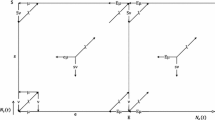Abstract
This paper presents solution procedures for determining close- to-optimal base stock policies in a multi-item two-echelon spare parts inventory system. The system consists of a central warehouse and multiple local warehouses, and there is a target for the aggregate mean waiting time per local warehouse. We develop four different heuristics and derive a lower bound on the optimal total cost. The effectiveness of each heuristic is assessed by the relative gap between the heuristic’s total cost and the lower bound. The results of the computational experiments show that a greedy procedure performs most satisfactorily. It is accurate as indicated by relatively small gaps, easy to implement, and the computational requirements are limited. Its computational efficiency can be increased by using Graves’ approximate evaluation method instead of an exact evaluation method, while the results remain accurate. That results in a feasible algorithm for real-life cases with many items and local warehouses.
Similar content being viewed by others
References
Altman E, Gaujal B, Hordijk A (2003) Discrete-event control of stochastic networks: Multimodularity and regularity. Springer, Berlin
Axsäter S (1990) Simple solution procedures for a class of two-echelon inventory problems. Oper Res 38:64–69
Axsäter S (1993) Continuous review policies for multi-level inventory systems with stochastic demand. In: Graves SC, Rinnooy Kan AHG, Zipkin PH (eds) Logistics of Production and Inventory, North-Holland, New York
Caglar D, Li CL, Simchi-Levi D (2004) Two-echelon spare parts inventory system subject to a service constraint. IIE Trans 36:655–666
Cohen M, Kamesam PV, Kleindorfer P, Lee H, Tekerian A (1990) Optimizer: IBM’s multi-echelon inventory system for managing service logistics. Interfaces 20:65–82
Dantzig GB, Wolfe P (1960) Decomposition principle for linear programs. Oper Res 8:101–111
Graves SC (1985) A multi-echelon inventory model for a repairable item with one-for-one replenishment. Manag Sci 31:1247–1256
Hajek B (1985) Extremal splittings of point processes. Math Oper Res 10:543–556
Hausman WH, Erkip NK (1994) Multi-echelon vs. single-echelon inventory control policies for low demand items. Manag Sci 40:597–602
Hopp WJ, Zhang RQ, Spearman ML (1999) An easily implementable hierarchical heuristic for a two-echelon spare parts distribution system. IIE Trans 31:977–988
Kranenburg AA (2006) Spare parts inventory control under system availability constraints. PhD thesis, Technische Universiteit Eindhoven, Eindhoven, The Netherlands
Kranenburg AA, van Houtum GJ (2007) Effect of commonality on spare parts provisioning costs for capital goods. Int J Prod Econ (in press)
Muckstadt JA (1973) A model for a multi-item, multi-echelon, multi-indenture inventory system. Manag Sci 20:472–481
Muckstadt JA, Thomas LJ (1980) Are multi-echelon inventory methods worth implementing in systems with low-demand-rate items? Manag Sci 26:483–494
Rustenburg JW, van Houtum GJ, Zijm WHM (2003) Exact and approximate analysis of multi-echelon, multi-indenture spare parts systems with commonality. In: Shantikumar JG, Yao DD, Zijm WHM (eds) Stochastic Modeling and Optimization of Manufacturing Systems and Supply Chains, Kluwer, Boston
Sherbrooke CC (1968) METRIC: a multi-echelon technique for recoverable item control. Oper Res 16:122–141
Sherbrooke CC (2004) Optimal inventory modeling of systems. Kluwer, Boston
Slay FM (1984) VARI-METRIC: An approach to modelling multi-echelon resupply when the demand process is Poisson with a gamma prior. Technical Report AF301–3, Logistics Management Institute, Washington D.C
Sobel MJ, Zhang J (2004) Interchanging fill rate constraints and backorder costs in inventory models, Working paper TM-779, Department of Operations, Case Western University, Cleveland, USA
Thonemann UW, Brown AO, Hausman WH (2002) Easy quantification of improved spare parts inventory policies. Manag Sci 48:1213–1225
Van Houtum GJ, Zijm WHM (2000) On the relation between cost and service models for general inventory systems. Stat Neerl 54:127–147
Wong H, van Houtum GJ, Cattrysse D, Van Oudheusden D (2005) Simple, efficient heuristics for multi-item multi-location spare parts systems with lateral transshipments and waiting time constraints. J Oper Res Soc 56:1419–1430
Wong H, van Houtum GJ, Cattrysse D, Van Oudheusden D (2006) Multi-item spare parts systems with lateral transshipments and waiting time constraints. Eur J Oper Res 171:1071–1093
Author information
Authors and Affiliations
Corresponding author
Rights and permissions
About this article
Cite this article
Wong, H., Kranenburg, B., van Houtum, GJ. et al. Efficient heuristics for two-echelon spare parts inventory systems with an aggregate mean waiting time constraint per local warehouse. OR Spectrum 29, 699–722 (2007). https://doi.org/10.1007/s00291-007-0077-4
Published:
Issue Date:
DOI: https://doi.org/10.1007/s00291-007-0077-4




